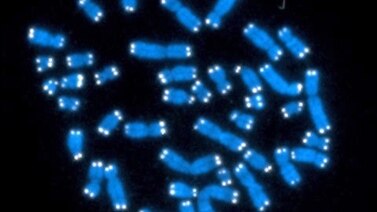(MUSIC)
VOICE ONE:
This is SCIENCE IN THE NEWS in VOA Special English. I'm Bob Doughty.
VOICE TWO:
And I'm Pat Bodnar. This week: underwater action -- studying the movements of baby coral...
VOICE ONE:
Some award-winning environmental activists.
VOICE TWO:
And ancient dentistry -- people were getting their teeth drilled a lot earlier than scientists have thought.
(MUSIC)
VOICE TWO:
Some coral reefs are small. Others extend for thousands of kilometers. But a genetic study of coral reefs in the Caribbean Sea shows that corals do not move very far from their place of birth. Experts say this finding could help scientists and policymakers to better direct their efforts to protect local reefs.
Coral polyps are small animals. They usually live in colonies. There are different kinds of corals, including the kind that build reefs.
Reefs start to form as corals attach to rocks or other hard surfaces underwater. As colonies die, they leave limestone remains. Other corals build on them. Over time, these structures grow into reefs along shorelines and around islands.
VOICE ONE:
Researchers Stephen Palumbi and Steven Vollmer recently examined staghorn coral in the Caribbean. Mister Palumbi works at Stanford University in California. Mister Vollmer works at the Smithsonian Tropical Research Institute in Panama. They did the study for the Bahamas Biocomplexity Project at the American Museum of Natural History in New York City.
The researchers studied free-swimming young coral. The goal was to learn if these coral larvae could help repopulate damaged reefs.
They examined the genetic material of more than two hundred sixty coral samples. These were collected from an area that extended from the Bahamas to Panama and from the Yucatan Peninsula to Curacao. The scientists measured similarities to find out how closely the corals were related.
They found that some coral collected between two kilometers and one hundred kilometers apart were related. But samples collected one hundred to five hundred kilometers apart were unrelated. The scientists say this shows that young coral do not travel very far. Their swimming distance is not enough to repopulate damaged reefs.
VOICE TWO:
Pollution, coastal development and too much fishing can all damage coral reefs. So can severe storms. Some researchers have estimated that ten percent of the world's coral reefs are damaged beyond repair. They say more than half of all coral reefs are threatened.
Coral is important to sea life. It is also used in manufacturing, medicine and jewelry. It is valuable to the environment, as well as the economies of some countries. People who visit places like the Bahamas want to see beautiful coral reefs.
VOICE ONE:
The loss of reefs is especially bad in the Caribbean. The American Museum of Natural History says coral cover in the area has decreased over the years by eighty percent.
Stephen Palumbi says growing coral in a laboratory to repair damaged reefs is not a realistic solution. He says coral develops at a yearly rate of only about one centimeter.
(MUSIC)
VOICE TWO:
You are listening to SCIENCE IN THE NEWS in VOA Special English from Washington.
Winners of the Goldman Environmental Prize have been announced. The yearly award is the largest of its kind. Winners receive one hundred twenty-five thousand dollars for their environmental activism.
VOICE ONE:
The six winners this year include Silas Siakor, the winner for Africa. He gathered evidence against former Liberian president Charles Taylor. Mister Siakor showed that Mister Taylor used profits from illegal tree-cutting operations to help pay for the civil war that lasted fourteen years in Liberia. The information led to a continuing United Nations ban on Liberian wood exports.
Yu Xiaogang is the prize winner from Asia. He studied the effects of dams on communities in China and developed related programs. Prize officials say his work helped lead the government to now consider the social effects of such projects on villagers.
Tarcisio Feitosa da Silva is the winner for South and Central America. He was honored for his efforts in Brazil to create the world’s largest area of protected rain forest. Mister Feitosa faced death threats for reporting illegal tree cutting to the government.
VOICE TWO:
Ukrainian lawyer Olya Melen won the Goldman prize for Europe. She was able to temporarily halt the building of a major waterway through the Danube Delta, a valuable wetland area. The former Ukrainian government denounced her actions, which took place through the legal system.
The award for islands and island nations went to Anne Kajir of Papua New Guinea. Prize officials say she found evidence of widespread government involvement in illegal tree cutting.
In nineteen ninety-seven, she successfully defended an appeal before the Supreme Court of Papua New Guinea. It was her first year working as a lawyer. Prize officials say the final ruling led to payment of damages to local landowners.
VOICE ONE:
And this year's winner of the Goldman Environmental Prize for North America is Craig Williams of the United States. He successfully appealed to the Defense Department to halt plans to burn old chemical weapons stored around the country. Mister Williams started a campaign in nineteen eighty-five to call for safer ways to destroy them.
Mister Williams and the other winners were honored with a ceremony in late April in San Francisco, California. Richard and Rhonda Goldman established the prize in nineteen ninety.
(MUSIC)
VOICE TWO:
Scientists say they have recovered the earliest known evidence of dental work. They report finding eleven human teeth with small holes carefully made in them. The teeth came from nine adults who lived between seven thousand five hundred and nine thousand years ago. That means dentistry is about four thousand years older than experts had thought.
Roberto Macchiarelli of the University of Poitiers in France led the study. He and the research team worked at a burial area in what is now Pakistan. Nature magazine published a report on the study.
VOICE ONE:
The researchers say they found examples of dental work in the remains of both men and women. They used microscopes and other equipment to examine small holes cut in the eleven teeth.
The researchers do not believe the holes were drilled for ceremonial reasons or for beauty. They say some of the teeth showed signs of disease. They suggest that some kind of material may have been placed as a filling in the damaged areas.
The researchers also found pieces of drills they suspect were used to make beads for artwork. Beads with holes drilled in them can be worn as jewelry. The researchers say the same technology was also used to treat damaged teeth.
(MUSIC)
VOICE TWO:
The most effective treatment today for malaria is made from a plant found in China and Vietnam. But supplies of the sweet wormwood are limited. Now researchers led by Jay Keasling at the University of California, Berkeley, have a possible solution.
They placed genes from the plant into a yeast organism and got it to produce large amounts of artemisinic acid. This acid can be made into the drug, artemisinin, in just a few chemical steps. A report appeared in the journal Nature.
The scientists say their process could reduce the cost of the active substance in artemisinin by ninety percent. But they say the genetically engineered version is still about five to ten years away from final development.
VOICE ONE:
One more thing. The World Health Organization says artemisinin should always be used in combination with other malaria drugs. If not, experts worry that resistant forms of malaria could defeat it sooner instead of later.
(THEME)
SCIENCE IN THE NEWS was written by Jerilyn Watson, Lawan Davis, Jill Moss and Cynthia Kirk, who was also our producer. I'm Bob Doughty.
VOICE TWO:
And I'm Pat Bodnar. Read and listen to our programs at voaspecialenglish.com. And if you have a science question, send it to special@voanews.com. We might be able to answer it on our show. Join us again next week for more news about science in Special English on the Voice of America.



